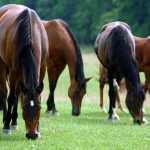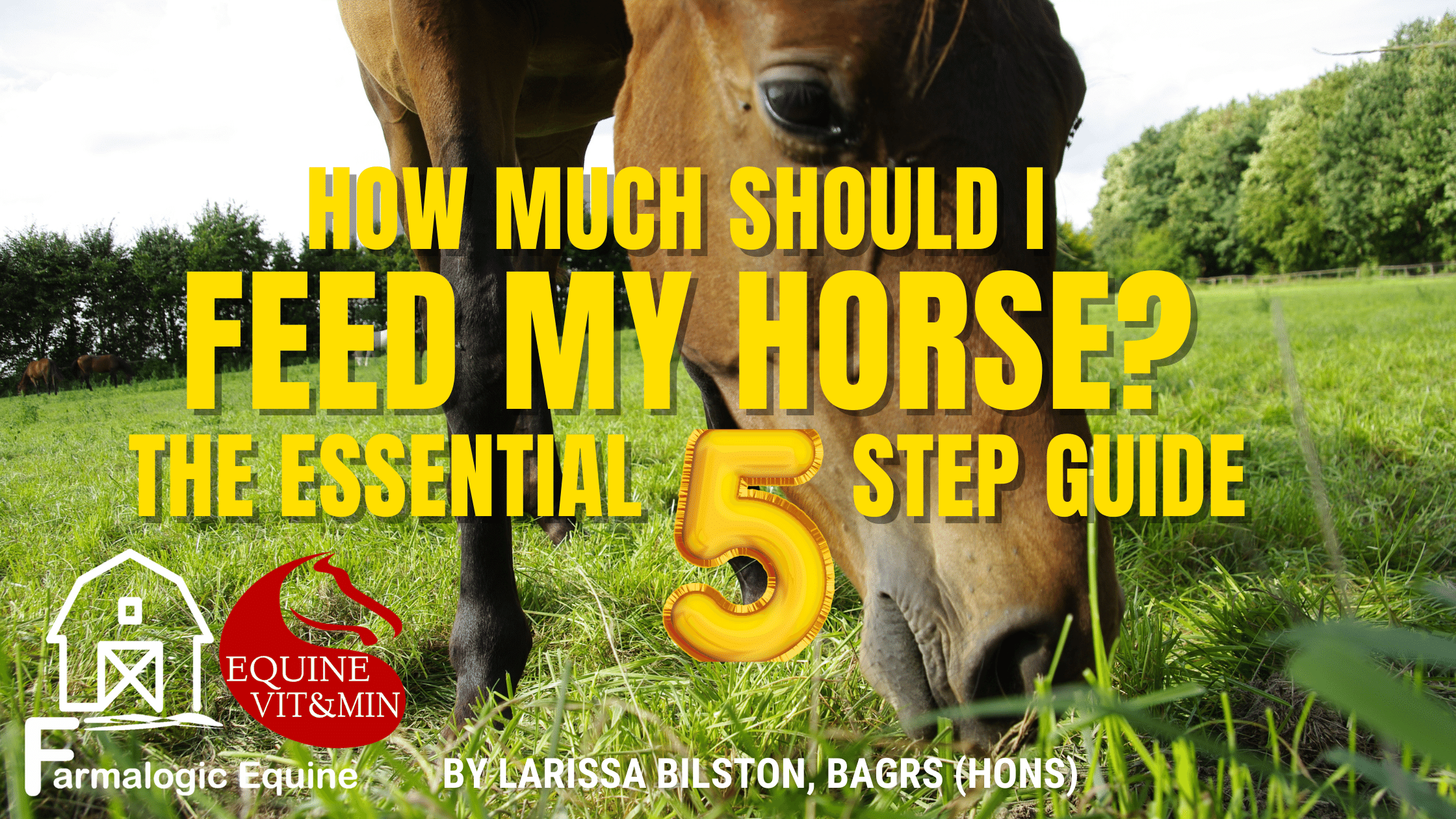The amount of food your horse requires is determined by his or her size (weight), workload, age, breeding status and whether you are aiming for weight loss, maintenance or gain. This guide outlines the five essential steps you need to follow to work out how much to feed your horse.
- Measure or estimate your horse’s weight.
- Determine the Body Condition Score (BCS) to decide whether you want to help him/her gain, lose or stay the same weight.
- Define your horse’s workload.
- Calculate total daily intake requirement.
- Match calories from forage, hard feeds and supplements to your horse’s daily energy requirements.
1. Measure or Estimate Body Weight (BW)
There are various methods to estimate your horse’s body weight:
- Breed or Body Type Guides

- Weight tapes – these measure ‘heart girth’ and can be surprisingly accurate, especially for ‘TB-shaped’ horses.
- Formula Method:
Horse Weight (kg)=[heart girth(cm)2 x body length(cm)] / (11,880 cm3) where length is defined as “measuring from the point of shoulder to the point of buttock” and “heart girth” is the measurement around the body of the horse level with where the girth sits.
- There are a few useful online calculators based on these formulae available online for free use. Click here for an example from The Horse.
Livestock scales to weigh your horse are the ultimate answer to the question “What does my horse weigh?” If you have access to a vehicle weigh bridge, weighing your truck or car and float with the horse on-board and subtracting the weight of the vehicles without the horse is another method for weighing an animal as large as a horse.
2. Determine Body Condition Score (BCS)
Body Condition Scoring is a useful tool for monitoring the balance between dietary energy (calories consumed) compared to the amount of energy your horse is using (for body maintenance, keeping warm, working, etc).
There are various body scoring systems available, ranging from 5 point to 9 point scales. They all rely on estimating body fat using a combination of visual assessment and feeling the horse. It is strongly recommended that all horse owners become proficient in using a BSC system so that you always know whether your horse is gaining, losing or maintaining weight.
To feed your horse correctly, at any point in time you need to accurately answer the following question:
“Does your horse need to lose, gain or maintain bodyweight?”
Click here to go to Wikipedia for more information on the 9 point Henneke body condition scoring system. The University of Minnesota has prepared an excellent teaching video to demonstrate how to look, feel and calculate your horse’s Henneke BCS. Click here to go to the YouTube teaching video.
Click here to see a five point horse body condition scoring system on the Agriculture Victoria website.
3. Define Workload
The NRC (National Research Council) defines weekly workloads in the publication ‘Nutrient Requirements of Horses‘ to help owners and nutritionists ensure that horses are fed appropriately, according to their daily nutritional needs for their work level.
 Maintenance
Maintenance
A horse not being ridden or lunged can be defined as a horse at ‘maintenance.’ You might sometimes see this referred to as being at ‘rest’ or ‘spelling’.
Some nutritionists even define whether the unworked horse has a high or low level of activity (depending on the paddock size and temperament of the horse).
 Light Work
Light Work
A horse in light work performs 1 – 3 hours per week: 40% walk, 50% trot, 10% canter with an average heart rate of 80 beats per minute (bpm) over the ride.
Light work could include horses used for recreational (trail or pleasure) riding, working ponies, horses during the early stages of training or beginning breaking in or show horses given occasional work.
 Moderate Work
Moderate Work
A horse in moderate work is performs 3 – 5 hours per week: 30% walk, 55% trot, 10% canter, 5% low jumps or other skill work with an average heart rate of 90 bpm over each ride.
This typically includes horses used for more regular recreational (trail) riding, beginning training/breaking, show horses, dressage, campdraft, polo or polocrosse, stock work, cutting horses, showjumpers and low level eventers.
 Hard Work
Hard Work
Hard (or Heavy) work is defined when a horse performs 4-5 hours per week: 20% walk, 50% trot, 10% canter, 15% gallop, jumping or other skill work with an average heart rate of 110 bpm over the session.
Hard working horses may be performing stock work, polo, high level dressage or show jumping, medium level eventing, race training.
 Very Heavy Work
Very Heavy Work
Very Heavy (or Intense) work is performed by racehorses, elite 3 day eventers and endurance horses.
Their work varies – it can be 1 hour per week speed work or 6 – 12 hours per week of slow work. Their average heart beat will be in the range 110 – 150 bpm.
Once you have identified how hard your horse works, you can use this information to calculate how much food (total intake) is needed each day, and the amount of hard feed and supplements required to provide enough energy (calories), protein, vitamins and minerals.
4. Calculate Daily Intake Requirement
The table below is a guide to estimating how much your horse needs to eat each day. Feed is measured by it’s DRY MATTER (DM) content which is how much the feed weighs after all water is removed. As a rule of thumb, hay is around 80% DM, hard feeds 90% DM, powdered supplements 95 – 99% DM compared to grass which can range from as little as 20 or 30% DM when lush and leafy, to 80% or more when mature and dry.
 The daily dry matter intake will vary according to workload, horse preference for the forage source, and whether the horse needs to be restricted for weight loss.
The daily dry matter intake will vary according to workload, horse preference for the forage source, and whether the horse needs to be restricted for weight loss.
All horses, including racehorses in very heavy work, require AT LEAST 1% of their bodyweight in roughage every day for good gut health.
5. Match Calories Fed to Digestible Energy (DE) Requirement
Many horses (especially ponies, easy keepers and horses at rest or in light work) consume all the calories they need from their forage source. Hard keepers, breeding, growing and hard working horses often need a concentrate feed to provide enough calories to maintain body condition or gain weight. The amount of concentrate required depends on:
- Workload
- Calorie content of the forage
- Calorie content of the hard feed
- Whether weight loss, gain or maintenance is required (Click here for more information about weight gain)
- Individual horse metabolism.
The icing on the cake to perfect any horse diet are the vitamin, mineral, protein and omega-3 supplements needed to overcome deficiencies from the rest of the diet and create a balanced diet.
As a part of our strong commitment to customer service, and to help save you money, our team of university qualified equine nutritionists offer a free diet analysis to fine-tune your horse’s diet and calculate the type and level of supplementation your horse requires. To access this complementary service, please weigh your horse’s feeds then visit Farmalogic Equine here.




